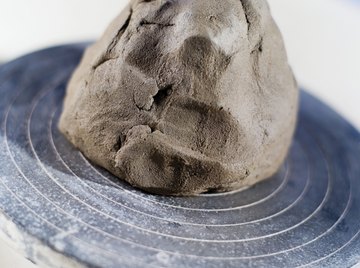
Experiments that investigate flotation and buoyancy can be difficult if you don't have access to materials that can be manipulated and shaped. This is because testing the factors that contribute to buoyancy depend on the surface area of the object intended to float or sink. Clay works well for these experiments, as you can easily measure several identical masses of clay and then shape them according to the needs of the experiment.
Predictions
Before you begin with an experiment, ask yourself questions that will drive your investigation forward. For example, if you're experimenting to determine simply if clay sinks or floats, ask yourself what you already know about clay, so you can predict what will happen when you put clay in water. If you're testing to see if the shape of clay has an effect on whether it sinks or floats, write down your ideas about which kinds of shapes will be sinkers and which will be floaters. These predictions will be your hypotheses -- educated guesses -- that you will test with your experiments.
Procedures
Once you've identified what you want to investigate and what you expect will happen, set up and conduct your experiment. You may only have to drop a hunk of clay into a bucket of water to see if it floats. However, if you are testing how shape affects buoyancy, take two identical masses of clay and fashion one into a ball while you shape the other into a flat board or barge shape. You can also experiment with different amounts of water or even with different types of water. For example, you could have two water samples: one with fresh water and one with salt water.
Observations
While you conduct your experiment, record everything you observe as well as all of the materials you use. For example, make sure you write down the volume and type of each water sample you use. Also, make sure you record the mass of each sample of clay as well as the dimensions of each shape you create with each sample. If possible, use a stopwatch and time how long it takes each clay sample to sink. You can even supplement your written observations with drawings and diagrams.
Results and Responses
Now that you've conducted your experiment and recorded your observations, you need to examine your results and determine if your hypotheses were correct, incorrect, or if your results were inconclusive and you need to do more investigations. For example, if you were trying to determine which shapes were better suited for flotation, you probably noticed that a barge-shaped piece of clay floated while a ball of clay sunk. This is because the barge-shaped clay displaced an amount of water equal to its own weight. In other words, its surface was spread out enough so that more water was beneath it, holding it up.
References
About the Author
Christopher Cascio is a memoirist and holds a Master of Fine Arts in creative writing and literature from Southampton Arts at Stony Brook Southampton, and a Bachelor of Arts in English with an emphasis in the rhetoric of fiction from Pennsylvania State University. His literary work has appeared in "The Southampton Review," "Feathertale," "Kalliope" and "The Rose and Thorn Journal."
Photo Credits
Stockbyte/Stockbyte/Getty Images
